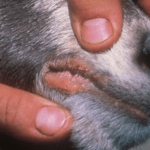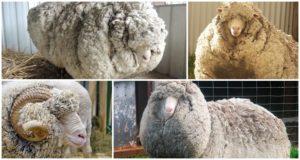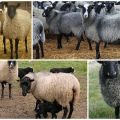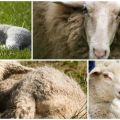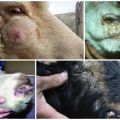Symptoms of contagious ecthyma of sheep and the virus pathogen, how to treat
Contagious ecthyma is a viral disease of sheep, in which ulcers, vesicles, papules and crusts form on the oral mucosa, skin of the lips, genitals and udder. The most susceptible animals are between 1.5 and 3 months of age. The mortality rate of young animals is 90%, of adults - 5-10%. In scabs at room temperature, the virus can persist for up to 15 years.
The causes of the disease
The causative agent of contagious ecthyma is an epitheliotropic virus belonging to the Poxviridae family. Under favorable conditions in the external environment, it persists for a rather long time - from 4 to 15 years. At high air humidity and under the influence of high temperatures, it disinfects quickly.
Carriers of the disease are recovered or infected individuals. Their excretions enter the external environment, infecting litter, drinkers, feeders, pastures. If there are papules and vesicles on the udder of the ewe, the lambs will be infected.
Outbreaks of contagious ecthyma occur in young sheep when they are weaned from their mother and transferred to other pastures. The total maintenance of healthy and infected animals leads to the fact that in 2-3 weeks from the moment of infection, the parapox virus infects the entire herd.
Signs and symptoms
Depending on the dose of the virus that entered the animal's body, its immunity, the incubation period ranges from 4 to 8 days. In young sheep, abscesses and papules are formed:
- on the mucous membrane of the oral cavity;
- on bare scalp (nostrils, eyelids, cheeks);
- genitals.

First, red spots appear in the corners of the mouth and along the edges of the lips, inside which nodules are formed, turning into pustules and vesicles. After a while, they open up, the integrity of the mucous membrane is violated. In place of abscesses, scabs and a dry crust of dark brown color are formed. Infected lambs have fever and find it difficult to eat and drink water. As a result of exhaustion, almost 90% of the young die.
If the virus has infected the lamb's hooves, they become sensitive, the animal limps. The genital form of the disease is characterized by the formation of abscesses and crusts on the inner thighs, on the foreskin of the penis, on the udder. The recovery period for individuals who have been reinfected is 40-50 days.
Diagnostic rules
To establish the fact of the disease of sheep help:
- Clinical laboratory analyzes of smears. Samples of scabs or purulent discharge are sent for research. If group or fractional colonies of dark red elongated bodies of the epithelotropic virus are found in them, the animal is infected.
- Biological samples. They are carried out on clinically healthy individuals by rubbing the liquid from the scabs into the inner surface of the thigh of their skin. If, 3-5 days after infection, the classic symptoms are observed in lambs, this is contagious ecthyma.
When making a diagnosis, it is necessary to exclude diseases such as mycotic dermatitis, necrobacteriosis, foot and mouth disease and smallpox.

How to treat contagious ecthyma of sheep
Having found signs of damage to sheep by the parapox virus, they begin to treat it:
- the virus reached the oral mucosa. Therapy involves treating the affected area with 1% potassium permanganate solution, 5% copper sulfate, 3% carbolic acid emulsion, 3% hydrogen peroxide;
- in case of damage to the skin, a 10% solution of copper sulfate, salicylic or dibiomycin ointment, tincture of iodine are used.
If the sheep practically does not take food (severe course of the disease), they are treated with the listed agents or they are prescribed broad-spectrum antibiotics, coupled with biomycin.
Disease prevention
Measures to prevent the spread of the disease:
- separation of infected individuals from the general herd;
- taking preventive measures in the external environment to destroy the pathogen;
- when buying sheep from other subsidiary farms, animals are quarantined for up to 30 days. During this period, they are examined for signs of disease every week;
- keeping watering places, pastures and sheep farms in a condition corresponding to sanitary and veterinary standards;
- timely vaccination of animals, after which sheep become immune to the virus for 6-8 months;
- regular implementation of measures for the disinfection of inventory, equipment, work footwear and clothing, buildings and the surrounding area.
It is not recommended to graze livestock on pastures where sick animals were kept for 2 years.

